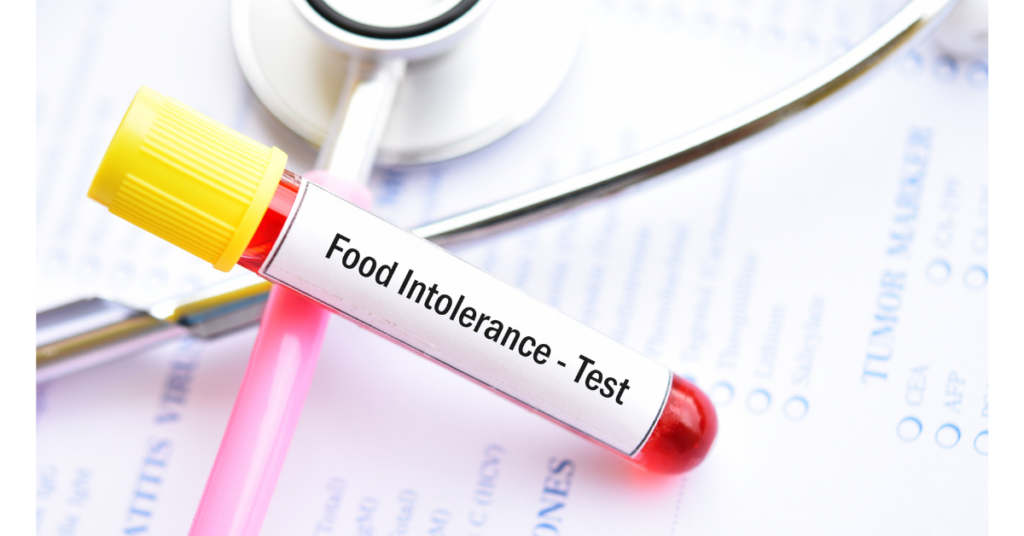Food Intolerance
Reactions and symptoms are usually triggered by food that is ingested frequently, with symptoms tending to be chronic or recurrent with multiple organ involvement.
Incidence
Up to 40% Europeans are affected to a degree by food intolerance.
Signs and Symptoms
Often occur hours and sometimes days after the food is eaten.
Respiratory: Asthma, rhinitis and sinusitis.
Gastrointestinal: Abdominal distension, bloating, vomiting, diarrhoea, and colic.
Dermal: Urticaria, eczema, and atopic dermatitis.
Central Nervous System: Headache, migraine, impaired concentration, depression, hyperactivity, and mood changes.
Musculoskeletal: Weakness, aching, myalgia, arthritis.
Mechanism
Food intolerance symptoms are caused by the formation of immune complexes with a specific immunoglobulin G (IgG). Raised levels of this antibody help to identify foods that the patient has a strong, moderate, and no response to.
How food intolerances develop
The following factors can predispose / exacerbate an individual to developing food intolerance:
Eating the same type of foods frequently
Eating too rapidly and under chewing
Eating large quantities of food at the same time
Eating processed foods regularly
Repeated use of antibiotics, alcohol, and anti-inflammatory medications
Viral / bacterial or parasite infection
Most common food intolerance allergens:
Cow / goat milk, eggs
Wheat, yeast, oats, barley, soya
Coffee, cocoa bean
Prawns, salmon, plaice, cod
Tomato, grapefruit
Tests and Investigations
The Enzyme-Linked Immunosorbent assay (ELISA) provides a rapid and precise test for food intolerance. This measures the amount of food specific IgG antibodies created within the blood against a number of different foods.
Hair Analysis detects mineral deficiencies and the presence of toxic metals.
Treatment Options
Self Help
There is no cure for allergies. Treatment includes avoiding the foods that cause allergies, strengthening the immune system, and treating symptoms as they occur.
Keeping a diary of every food and substance used might help to identify possible allergens.
Conventional Treatment Strategies
Antihistamines such as loratadine (Clarityn); reduces itching, swelling, runny nose, and headache.
Adrenaline injection for anaphylactic reactions.
Corticosteroids can be used either as a tablet or topical application to prevent allergy symptoms from occurring.
Complementary Treatment Strategies
Biochemical Strategies
Diet and Nutrition
An elimination / challenge diet trial may help uncover sensitivities. Remove suspected foods from the diet for 2 weeks.
Eliminated foods should be re-introduced one at a time, watch for reactions.
A rotation diet, in which the same food is not eaten more than once every 4 days, may be helpful in minimising allergic reactions.
Reduce pro-inflammatory foods in the diet including saturated fats, refined foods, and sugar.
Increase intake of vegetables, whole grains, and essential fatty acids.
Evening primrose oil or flax seed are anti-inflammatory.
Zinc and beta-carotene supplements support immune function.
Vitamin C and bioflavonoids inhibit histamine release.
B-complex vitamins help immune function.
Avoid all stimulants, such as caffeinated drinks and white sugar as these can overstimulate the immune system, making the allergies worse.
Western Herbalism
Infusions of chamomile, elder flower, eyebright, and nettle have anti-inflammatory effects.
Quercetin minimises reactions to food.
A mixture of peppermint, chamomile, and passionflower will help digestion.
Energy Strategies
Homeopathy
Arsenicum album for a runny nose, itchy throat, and sneezing. Useful for people who are sensitive to many foods.
Allium cepa (Al. cepa) for runny nose, sore upper lip, and itchy eyes.
Apis for nettle rash and allergic swellings.
Nux vomica for cramping pains, indigestion, runny nose, and stuffiness.
Aromatherapy
Lavender and neroli for nasal congestion.
Melissa for hayfever.
Acupressure
The immune system can be strengthened by pressing your thumb on the top of your forearm, two thumb widths from the wrist joint. Repeat on the other forearm.
Colour Therapy
Use blue or green colours in the form of light or silk scarves over the throat and neck, and over the chest.
Psycho-Social Strategies
Hypnotherapy
Hypnotherapy can be used to ascertain the origin of the allergy, followed by treatment with suggestion therapy.


